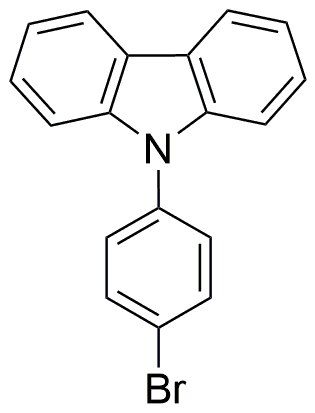9-(4-Bromophenyl)carbazole is widely utilized in research focused on:
- Organic Electronics: This compound is used in the development of organic light-emitting diodes (OLEDs), providing high efficiency and better color purity compared to traditional materials.
- Photovoltaic Cells: Its properties make it an excellent candidate for use in organic solar cells, enhancing energy conversion efficiency and stability.
- Fluorescent Sensors: The compound serves as a fluorescent probe in chemical sensing applications, allowing for the detection of various analytes with high sensitivity.
- Polymer Science: It is incorporated into polymer matrices to improve mechanical and thermal properties, making materials more durable and versatile for industrial applications.
- Pharmaceutical Research: The compound is explored for its potential in drug development, particularly in targeting specific biological pathways due to its unique structural features.
Informations générales
Propriétés
Sécurité et réglementation
Applications
9-(4-Bromophenyl)carbazole is widely utilized in research focused on:
- Organic Electronics: This compound is used in the development of organic light-emitting diodes (OLEDs), providing high efficiency and better color purity compared to traditional materials.
- Photovoltaic Cells: Its properties make it an excellent candidate for use in organic solar cells, enhancing energy conversion efficiency and stability.
- Fluorescent Sensors: The compound serves as a fluorescent probe in chemical sensing applications, allowing for the detection of various analytes with high sensitivity.
- Polymer Science: It is incorporated into polymer matrices to improve mechanical and thermal properties, making materials more durable and versatile for industrial applications.
- Pharmaceutical Research: The compound is explored for its potential in drug development, particularly in targeting specific biological pathways due to its unique structural features.
Documents
Fiches de données de sécurité (FDS)
La FDS fournit des informations de sécurité complètes sur la manipulation, le stockage et l’élimination du produit.
Spécifications du produit (PS)
Le PS fournit une description complète des propriétés du produit, notamment sa composition chimique, son état physique, sa pureté et les exigences de stockage. Il détaille également les plages de qualité acceptables et les applications prévues du produit.
Certificats d'analyse (COA)
Recherchez des certificats d'analyse (COA) en saisissant le numéro de lot du produit. Les numéros de lot et de lot se trouvent sur l'étiquette d'un produit, après les mots « Lot » ou « Lot de fabrication ».
Numéro de catalogue
Numéro de lot/série
Certificats d'origine (COO)
Ce certificat d'exploitation confirme le pays dans lequel le produit a été fabriqué, et détaille également les matériaux et composants utilisés et s'il est issu de sources naturelles, synthétiques ou autres sources spécifiques. Ce certificat peut être requis pour les douanes, le commerce et la conformité réglementaire.
Numéro de catalogue
Numéro de lot/série
Fiches de données de sécurité (FDS)
La FDS fournit des informations de sécurité complètes sur la manipulation, le stockage et l’élimination du produit.
DownloadSpécifications du produit (PS)
Le PS fournit une description complète des propriétés du produit, notamment sa composition chimique, son état physique, sa pureté et les exigences de stockage. Il détaille également les plages de qualité acceptables et les applications prévues du produit.
DownloadCertificats d'analyse (COA)
Recherchez des certificats d'analyse (COA) en saisissant le numéro de lot du produit. Les numéros de lot et de lot se trouvent sur l'étiquette d'un produit, après les mots « Lot » ou « Lot de fabrication ».
Numéro de catalogue
Numéro de lot/série
Certificats d'origine (COO)
Ce certificat d'exploitation confirme le pays dans lequel le produit a été fabriqué, et détaille également les matériaux et composants utilisés et s'il est issu de sources naturelles, synthétiques ou autres sources spécifiques. Ce certificat peut être requis pour les douanes, le commerce et la conformité réglementaire.


